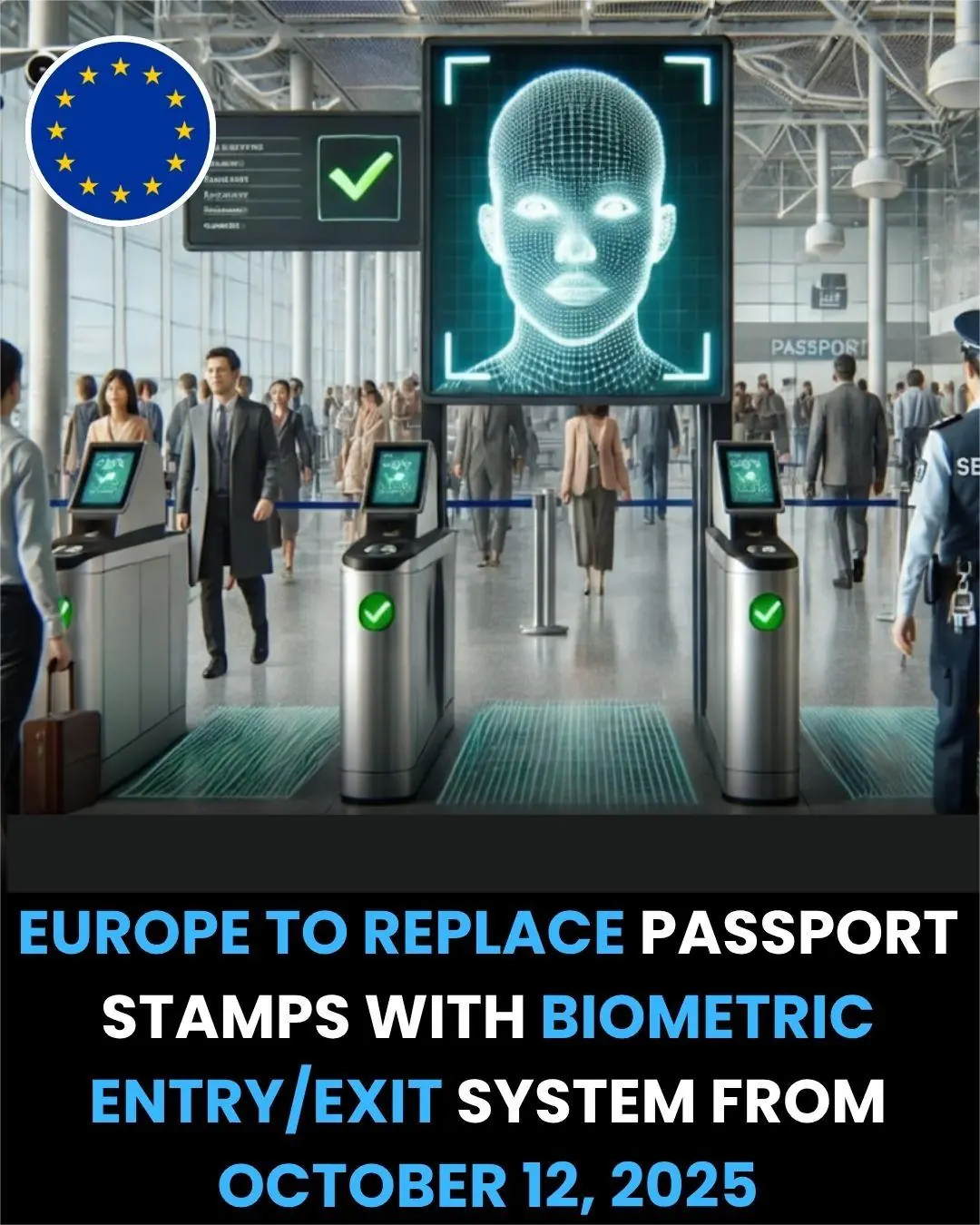
Europe to Replace Passport Stamps with Biometric Entry/Exit System Starting October 12, 2025
Europe is entering a new era of border control. Beginning October 12, 2025, the European Union will officially replace traditional passport stamps with a biometric Entry/Exit System (EES) — a digital platform designed to streamline border crossings and enhance security across all Schengen countries.
What the New System Means
Under the new system, non-EU travellers will no longer receive manual passport stamps when entering or leaving Europe. Instead, their biometric data — including facial images and fingerprints — will be scanned and stored in a secure digital database.
This information will automatically log the traveller’s entry and exit dates, replacing the need for physical ink stamps that border officers have used for decades.
The EES will apply to citizens from countries outside the European Union or the Schengen Area who visit Europe for short stays (up to 90 days within a 180-day period). EU citizens and residents are not affected.
Why the EU Is Making the Change
The biometric system aims to modernize border management, prevent document fraud, and help authorities better monitor overstays. It also allows for faster, more consistent checks at airports and land borders by eliminating manual passport stamping.
Officials say the move will strengthen both security and efficiency, ensuring that all entries and exits are recorded accurately in real time. It also aligns with the EU’s long-term plan for fully digital travel management and greater coordination among member states.
How It Will Work
Upon a traveller’s first arrival in the EU after the system launches, border officers will capture their biometric data and record personal details such as passport number, date of entry, and visa status. This digital record will remain valid for three years.
For subsequent trips within that period, the traveller will be able to pass through border gates more quickly, using facial recognition or fingerprint verification instead of manual inspection.
The EES will be gradually introduced at airports, seaports, and land crossings from late 2025 through early 2026. During this transition, some locations may still issue passport stamps until the system is fully operational.
Expected Impact on Travellers
While the new technology is expected to make travel smoother in the long term, authorities caution that initial delays are likely as passengers and border agents adjust to the new procedures. Travellers are advised to allow extra time for border processing during the first few months of implementation.
Once fully functional, the biometric system should reduce waiting times, minimize errors, and make travel records more transparent — eliminating the need for physical stamps while enhancing the overall security of the Schengen borders.
A Step Toward the Future of Travel
The launch of the Entry/Exit System marks one of the most significant updates to European border management in decades. By replacing passport stamps with digital records and biometrics, the EU is taking a major step toward the future of seamless, paperless travel — one where technology, not ink, keeps the world moving.
News in the same category


What it means when your partner turns away after making love

The Janitor Who Sent Five Children to College: A Father’s 18-Year Lesson in Sacrifice

Miss Universe Thailand’s Soda-Tab Gown: A Shining Tribute to Her Parents

China Develops Record-Breaking Super Camera Capable of Seeing Details 62 Miles Away

Japan’s Hybrid Coastal Defense: Engineering and Nature Working Together

Man in a Giant Dachshund Costume Steals Hearts Walking His Pet

Trapped in Darkness: How a Chinese Woman Survived 54 Hours in a Snake-Filled Well

The High Price of a Status Symbol: How a Teen’s Kidney-for-iPhone Deal Became a Cautionary Tale

❄️ Brave 11-Year-Old and Her Loyal Dog Save a Mother Goat and Newborn Kid in the Snow

A Young Man’s Act of Kindness Gives an Elderly Neighbor Comfort in Her Final Days

Running Through Grief — A Father’s Marathon of Love and Memory

Japan’s Gentle Way of Making Space — Moving Trees Instead of Cutting Them Down

The Moon and Saturn Meet — October 5

Pick A Bread To See What Kind Of Woman You Are

Zeus the Blind Owl — A Tiny Survivor With a Universe in His Eyes

Uber Will Soon Let You Book Helicopter Rides — A New Era of Urban Travel

From a Lost Check to a Life Rebuilt: The Remarkable Story of Elmer Alvarez

The Rickshaw Driver Who Changed Hundreds of Young Lives
News Post

The Science Behind Why Putting Something Cold Under Your Arms Can Calm You Down

What it means when your partner turns away after making love

Miracle Alert! 1 Leaf That May Support Healthy Blood Sugar, Cholesterol, and a Trim Waist

Chayote Juice: Unlock Natural Support for Joints and Bones

Why You Shouldn’t Pour Hot Water Into the Kitchen Sink

Is It Acceptable to Wear Underwear Two Days in a Row? A Surprising Answer

Debunking the Hype: Can One Food Really Rebuild Knee Cartilage Overnight?

The Janitor Who Sent Five Children to College: A Father’s 18-Year Lesson in Sacrifice

Miss Universe Thailand’s Soda-Tab Gown: A Shining Tribute to Her Parents

This Vitamin Could Help Reduce Blood Clot Risk in Your Legs – Seniors, Here’s What You Need to Know

6 Healthy Detox Juice Recipes for Wellness & Vitality

Top 10 Superfoods That May Help Reduce Proteinuria and Support Kidney Health

Miracle Mix: Castor Oil and Baking Soda for 15 Astonishing Health Benefits

Sparkle Like Never Before: 7 Natural Teeth-Whitening Secrets to Transform Your Smile ✨

Can Papaya Leaves Turn Gray Hair Black? Nature’s Secret to Youthful, Vibrant Locks!

Supercharge Your Defenses: 15 Mouthwatering Foods to Skyrocket Your Immunity Today

Unlock Thicker Hair in 30 Days: The Clove and Bay Leaf Secret You’ll Wish You Knew Sooner

Banish Blackheads with One Egg – The Ultimate Natural Secret Revealed!

